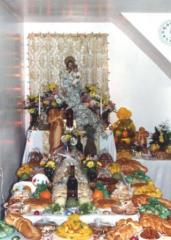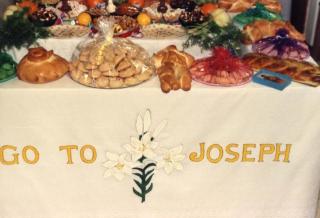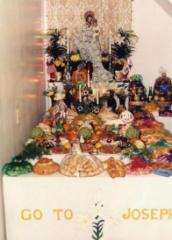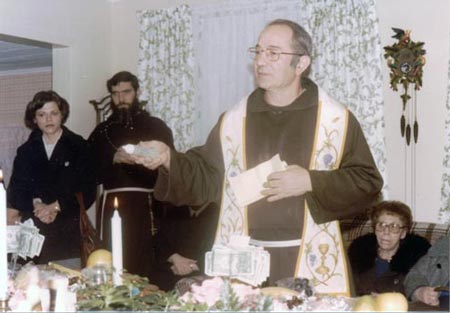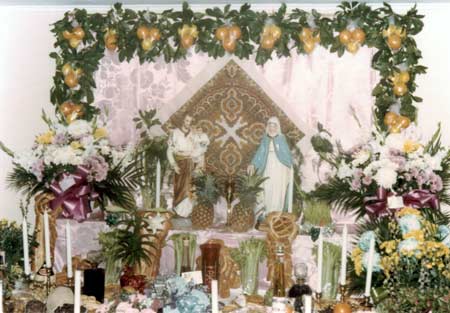Saint Joseph
Spouse of the Virgin Mary
Patron of the Universal Church:
March 19

"Of old it was said to the needy and suffering people in the kingdom of Egypt: 'Go to Joseph, and do all that he shall say to you.' (Gen. 41:55).
"The same is now said by the Sovereign Pontiff to all needy and suffering people in the kingdom of the Church:
Go to Joseph .
Unfailing petition to St. Joseph
Holy St. Joseph, Spouse of Mary,
be mindful of me, pray for me, watch over me.
Guardian of the paradise of the new Adam,
provide for my temporal wants.
Faithful guardian of the most precious of treasures,
I ask you to bring this matter to a happy end
if it be for the glory of God
and for the good of my soul.
Amen
Let's look at some of the things we know about St. Joseph:
He was the husband of the Virgin Mary and the adoptive father of Jesus Christ.
He is the Patron Saint of fathers, families, house hunters, carpenters, workers, of Canada, of Peru,
of social justice and of a happy death.
He was a Judean and a carpenter, and most likely passed away before Jesus.
The Custom of the Saint Joseph Table
The custom of the St. Joseph's Table started several centuries ago. A severe famine in Sicily caused considerable suffering and starvation. The farmers turned in prayer to St. Joseph for help. The famine soon ended and in gratitude the farmers honored St. Joseph by filling an altar with their most prized possession - food. Then they invited all the poor to serve themselves.
Later the tradition was celebrated in the home. The St. Joseph's Day table was done in remembrance of the famine and the Lord answering the people’s prayers through the intercession of St. Joseph. The St. Joseph altars have been handed down for generations. Some people made a promise to devote time, food or money to other people's altars instead of having an altar of their own. No meat is present at an altar because it is a Lenten celebration. The quantity of food denotes a feast even though no meat is served. Pasta is served and the most common way to prepare the sauce for the pasta is with the “finocchio” or anise plant and sardines. It is called Pasta “alla Milanese,” a western Sicilian dish. Breads, cookies, cakes and meatless dishes are elaborately prepared just for the altar, along with fruits and vegetables. A priest usually blesses the food.
The St. Joseph's altar ceremony begins with appearances of persons chosen to represent Jesus, Mary and Joseph. The Holy family eats first, after that everyone is welcome to eat.
Table preparations:
The table should be suitably decorated with linens and flowers. The colors should be white, yellow and green. (THERE SHOULD BE NO RED AT ALL ON THE TABLE, Even the sauce for the Milanese is not red but a brownish color due to the fennel and sardines.) There should be a statue of St. Joseph at the head or statues of the Holy Family. There should be at least two candles which are lit before the table is broken.
Symbols:
White and yellow cloths symbolize the graces necessary for a good life and good health. White is also the sign of purity which St. Joseph is the model of chastity
Oranges and lemons symbolize riches or the means needed to meet our temporal needs.
Bread symbolizes the food needed to live. St. Joseph was the provider for the holy Family.
Fish symbolizes safe journeys.
Fruits and vegetables symbolize the fruitful harvest. It was the first harvest after the famine in Sicily which started the custom of the Table.
Sweet pastries and candy symbolize happiness.
Breaking of the Table:
The table is always blessed earlier, either the day before the feast or the morning of the feast.
There are different rituals for the breaking of the table. The originals involve choosing different people to be the Holy Family. When this is done, places are set at the table for the “saints”. After the prayers, they eat first before anyone else. When the "Saints" are not used, a simple ritual of prayers is used.
The ritual we use at our table is as follows:
All the guests gather in the room with the table and the leader begins:
+In the Name of the Father, and the Son, and the Holy Spirit. Amen.
Call to Worship
Today we honor the memory of Saint Joseph, husband of Mary and patron of the Universal Church. We rejoice at this table, which is a sign of God’s generous blessings and our call to serve the poor and hungry.
Intercessions
Let us call upon the Name of the Lord through the intercession of Saint Joseph.
(response- St. Joseph, pray for us.)
In times of doubt and fear – (r)
For a good family life –
For a chaste and just life –
For prudence and bravery –
For patience –
For comfort in troubled times –
For hope in times of sickness –
For strength against the evil one –
For a happy death –
Protector of the Church –
Prayer
Glorious Saint Joseph, to you we raise our hearts and hands to implore your powerful intercession. Please obtain for us present and all those who have contributed to this devotion, the graces necessary for a good life and good health symbolized in the white and yellow cloths of this table; the means necessary to meet our temporal needs symbolized in the oranges and lemons ; the food needed to live symbolized in the bread; safe journeys symbolized in the fish; fruitful harvests symbolized in the vegetables and fruits; and happiness in this world symbolized in the sweet pastries.
Father, you entrusted our Savior to the care of Saint Joseph. By the help of his prayers may your Church continue to serve its Lord, Jesus Christ, who lives and reigns with You and the Holy Spirit, one God forever and ever. Amen
The table is broken with the following prayer as the leader hands everyone present an orange from the table.
O glorious Saint Joseph, through the love you bear to Jesus Christ, and for the glory of His Name, hear our prayers as we break this table, prepared in your name. Amen
Macaroni is then served followed by a tasting of everything on the table. Those who donate to the table and are not present, are sent bread and a tray with a taste of everything from the table.
PREVIOUS TABLES AT THE SORTINOS
PREVIOUS TABLES AT THE STAMILLAS

